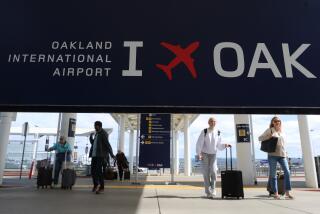THE URBAN LANDSCAPE : Excitement, Romance of Flight Still Alive at Municipal Airport
- Share via
Municipal airfields are to international airports what the Little League is to the Major Leagues in baseball. They offer nearby, easy-to-get-to, immediate excitement but few of the conveniences that make your outing to a big ballpark or to Los Angeles International Airport feel like a trip through a cocoon.
At the Santa Monica Municipal Airport, you won’t find separate arrival and departure ramps, carpeted walls, security gateways or endless air-conditioned corridors. All you get is the Tarmac itself, planes in plain sight and a group of individual little sheds.
The result is that the romance of flying comes to the fore. Santa Monica Airport has been quick to realize the advantage that its size and lack of facilities offers. Two trendy restaurants, one on each side of the runway, offer diners a view of the miracle of flight, and the Museum of Flying tries to explain it all.
Gates keep you off the actual landing area, but you can get close enough to almost touch Arnold Schwarzenegger’s private jet or Voyager designer Bert Rutan’s latest gravity-defying machine. For a fee, you can walk onto a plane and take off to survey the Westside from a distance that is far enough to give you a perspective but close enough to keep you in touch with your daily reality.
The office developments that cluster near airports are found in miniature in Santa Monica. Two- and three-story office buildings hug the northern edge of the field, their could-be-anywhere faces unfortunately turning their back to the airport. They make you realize that the airport lives in a kind of splendid isolation.
Located on top of a bluff, the airport rises over its neighbors to the east, west and south. The eastern and western edges are open rises filled only with grass and an occasional shrub, and the southern edge is a romantic hodgepodge of Quonset huts, hangars and dilapidated-looking aircraft service businesses.
The place is fairly rich with history because it was one of the hubs around which the aircraft industry of the 1920s took off. Donald Douglas had his plant nearby, and movie stars flew in and out. Prototypes and experiments have flown through here for at least 50 years, though rickety single-engine contraptions seem more in keeping with the spirit of the place. In 1988, the city built a new terminal, designed by the firm of Solberg & Lowe, which now keeps its offices in the rambling stucco and sheet metal building. Meant to evoke airplane wings with its curving roof, it is a rather innocuous addition to the confused scene of the airport.
Nothing would stand out much in this place, which is why it is so nice to spend time here. The runway overwhelms everything else with its stretch of open space drawn through the tightly packed Westside. It creates a gash reaching up into the sky and out to the landscape. Roads have to move around it, and people can’t live below it, leaving a kind of void inhabited only by these puny looking little airplanes that every day accomplish the miracle of flight in a way that seems much more visceral than it does at LAX. Undefined, a little messy and an impediment to proper development, Santa Monica airport evokes the excitement of nothing but empty space.
More to Read
Sign up for The Wild
We’ll help you find the best places to hike, bike and run, as well as the perfect silent spots for meditation and yoga.
You may occasionally receive promotional content from the Los Angeles Times.






